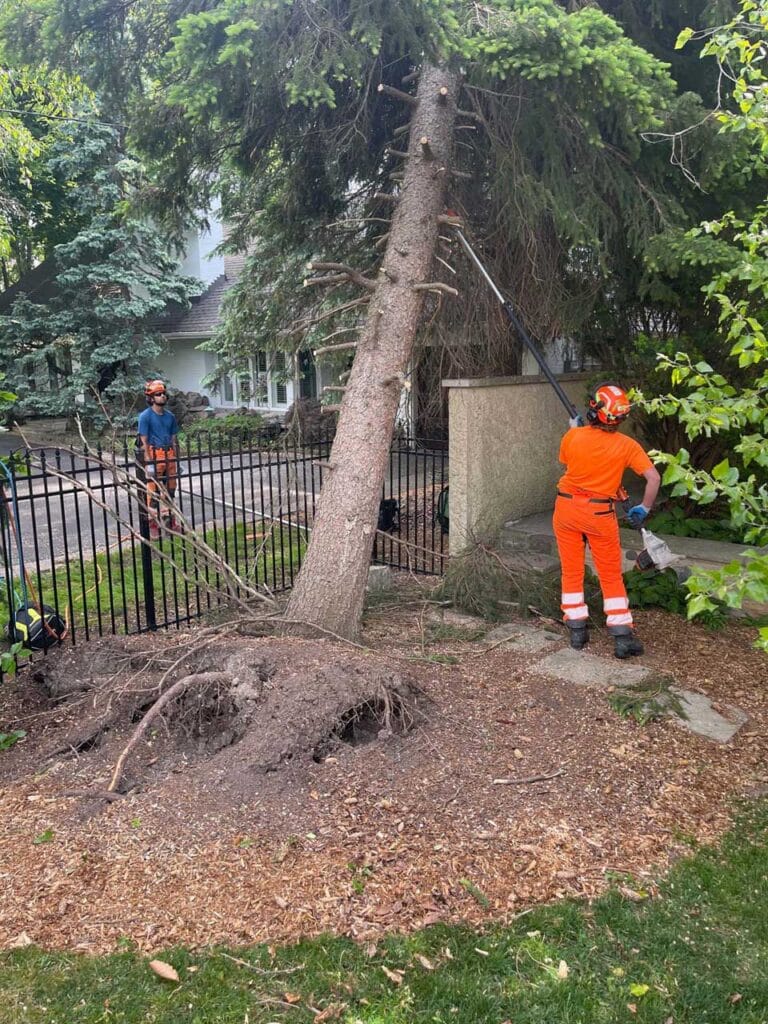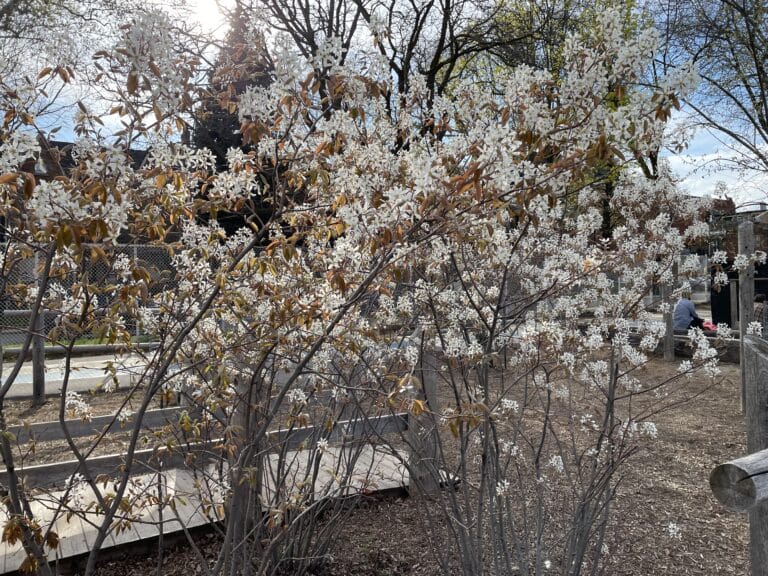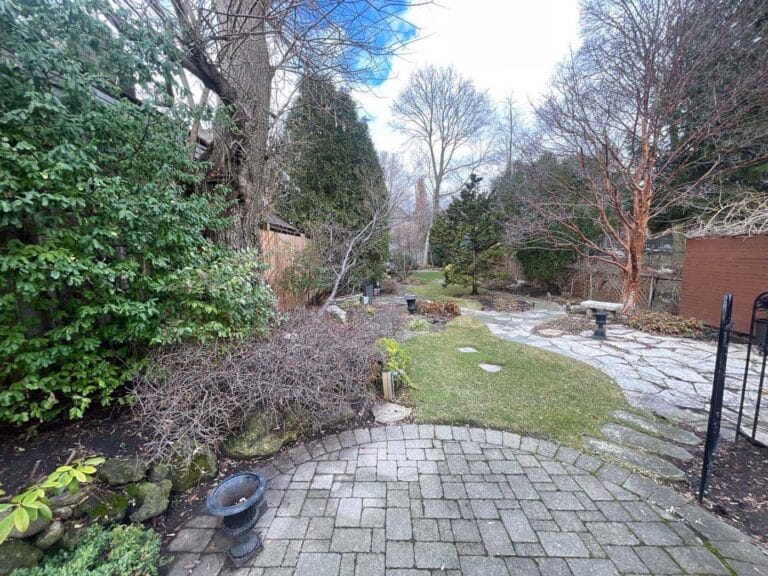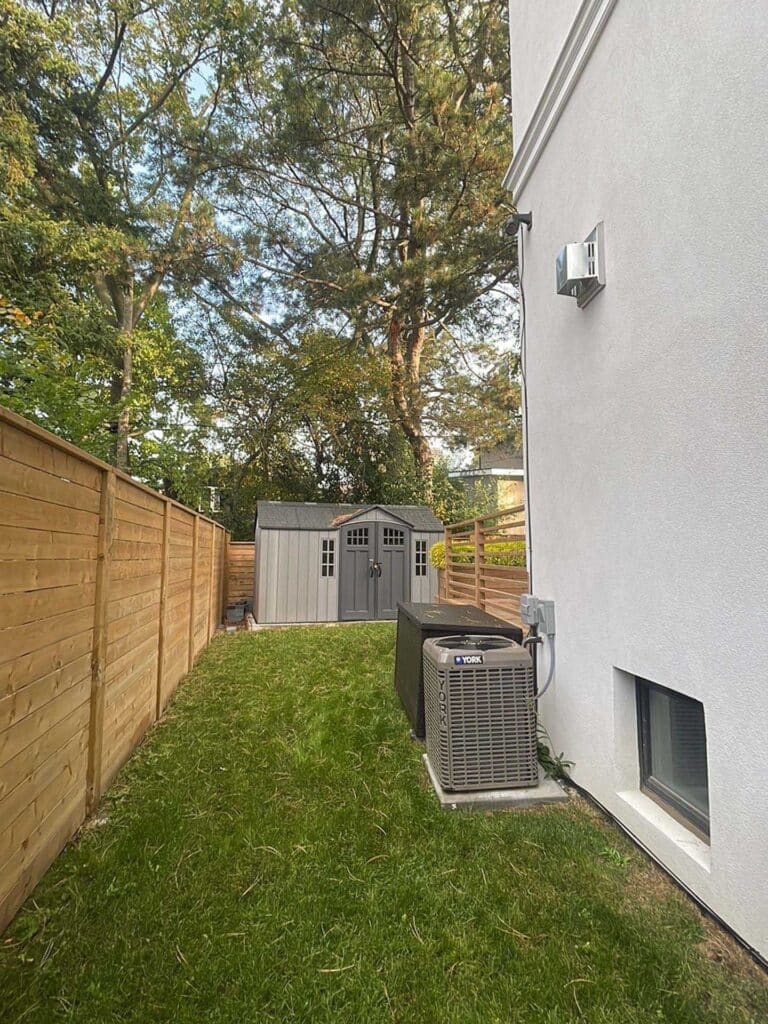Experiencing a neighbour’s tree falling onto your house can be an incredibly nerve-wracking and daunting situation. In addition to dealing with the immediate aftermath of the incident, you’ll also have to consider potential legal and insurance implications.
In this comprehensive blog post, we will delve into various aspects related to having a neighbour’s tree fall on your house and what happens next. We’ll begin by examining how liability is determined when a tree fails due to weather-related causes or negligence.
Next, we’ll explore homeowners’ insurance coverage for fallen trees. We’ll discuss important policy limitations and exclusions you should be aware of. One of the most important steps you can take right now is to check your insurance coverage and understand what to do if a neighbour’s tree falls.
We’ll provide essential information on how to protect your trees and home against storm damage before it happens. We will also emphasize the importance of hiring a professional tree service for preventative pruning and inspections to address potential hazards before they become big problems.
Lastly, we’ll talk about the role changing weather patterns have in storm damage to trees. Toronto and the GTA have had some serious storms over the past few years.
This wasn’t an anomaly. The increasing temperatures in the city and region can cause more volatile weather patterns, like wind storms and thunderstorms. In 2022, the derecho destroyed thousands of trees in the City. Summer 2023 is supposed to be very hot again, and the likelihood for more storms is high. We’ll talk about what you can do to protect your trees and home from climate change-related damage in the city.
1. Liability: Neighbour’s tree fell on my house, who’s responsible?
When a storm blows over a tree, its not the owner of the tree who is held responsible. A neighbour’s tree hitting your home or car will trigger your insurance, not your neighbours’. That’s why it’s always good to start on problems with a neighbour tree sooner rather than later.
If you don’t have insurance, this could be a very big problem. If the tree fell in a storm, in wind or as a result of other weather conditions, your neighbour likely won’t be held liable. It can get quite complicated to understand the implications of tree law in Ontario.
When a tree falls over in normal weather, the owner may be held liable but this is not guaranteed. Often, it becomes a matter of negligence and whether the owner of the tree to reasonable steps to ensure it was safe, knew, or ought to have known it was dangerous and did nothing.
You may also think the tree is solely the responsibility of your neighbour, but trees growing across property lines have been determined to be co-owned. The question isn’t where the majority of the trunk or canopy is, but rather where the tree meets the ground with its roots and what portion is on which property.
Since this article is written by arborists in Toronto and not lawyers, it isn’t legal advice and it doesn’t apply outside of the City of Toronto. Make sure you become familiar with the laws and regulations around this issue if you’re concerned, and consult with a lawyer well versed in this area
2.Understanding Homeowners’ Insurance and Fallen Trees
Don’t let a neighbour’s tree falling on your property or home stress you out – check your homeowners’ insurance policy to see if it covers the damages. If it doesn’t, inquire about adding this coverage if you’re worried about a tree near your property. If it does, clarify with your insurance company what they cover and don’t, and what the process is for making a claim for tree damage on your home. Insurance companies offer varying levels of coverage for tree-related incidents, so review your policy thoroughly and speak with an agent if you have questions.
Responsibility for Repair Costs and Removal Fees
- Tree on Your Property: Most policies will cover the cost of repairs up to certain limits, but may not pay for the full amount needed.
- Replanting or Replacement: You will likely not be covered for the cost of replanting, unless it is explicitly stated as covered
- Limitations on Scope of Work: Some policies will pay for the repair of a broken fence or roof, but not the cost associated with getting the tree off them to do the work, or any disposal fees involved
- Fallen Tree Damages Neighbour’s House: Your neighbour’s homeowners’ insurance should handle repairs unless there is evidence of negligence.
- Negligence Involved: If negligence is proven, the at-fault party could be responsible for all expenses
3. Disputes Between Neighbours Over Falling Trees
Rights and Responsibilities of Property Owners
Homeowners in Toronto have certain rights and responsibilities when it comes to tree maintenance and liability for damages caused by their trees.
- Gain insight into these rights and responsibilities by exploring here
- If a healthy tree falls due to extreme weather conditions, the homeowner whose property was damaged is responsible for repairs
- If negligence is demonstrated, the tree’s proprietor could be held accountable for any destruction
- You can call 311 in the City of Toronto to report a dangerous or hazardous tree
- The city can order a homeowner to prune or remove dangerous trees
- If the homeowner does not comply, the city may do the job for them and bill them
Avoiding Unnecessary Disputes Through Communication
- Talk openly with your neighbour about any potential hazards from their tree
- Offer assistance with tree trimming or tree removal costs to prevent future disputes
- Maintain records of any conversations regarding shared-tree concerns
- Familiarize yourself with local laws and regulations governing tree maintenance
- If a tree belonging to your neighbour falls onto your land, find out what steps to take and how to submit a claim for insurance
- If you’re the neighbour with the tree in question, reach out to multiple arborist companies for an opinion
- Act before it becomes a bigger issue
By working together to address potential hazards proactively, neighbours can maintain a positive relationship while ensuring the safety of their properties.
4. Proving Negligence in Tree Damage Cases
When your neighbour’s tree falls on your home due to their negligence, you need evidence to support your insurance claim and prove contributory negligence. This is not legal advice and should not be taken as such – speak to a lawyer to clarify the laws and regulations in your jurisdiction.
Gathering Evidence
If it’s your neighbour’s tree:
- Take photos or videos of the fallen tree and damage caused
- Document any prior warnings given about the hazardous condition of the tree
- Document any work you have had done or offered to do
- Consult an arborist for a professional assessment if necessary
If it’s your tree:
- Keep records of any tree work performed by Certified Arborists
- Document communication with your neighbour
- Get a professional tree inspection or arborist report
- Maintain open communication with your neighbour
5. Hiring Professional Tree Specialists

Don’t allow anyone on your property to do storm damage cleanup without a written contract, proof of insurance (general liability for commercial companies, and WSIB in Ontario) to ensure you’re protected. Ask for credentials, and verify their details. Storm cleanup is a time when many fly-by-night operators come out of the woodwork to make money, but storm work is deadly. Work done for cash or with an unqualified company will likely not be reimbursed by insurance.
Why Hire Professionals for Tree Removal?
- Safety: Removing fallen trees can be dangerous, but pros have the gear and know-how to handle it
- Efficacy: Pros will remove all debris without causing more damage or hassle
- Certified & Insured: Certified and insured arborists take responsibility for any accidents or damages
Periodic Inspection of Trees for Potential Hazards
Regular inspections by an expert arborist can identify issues before they become costly disasters.
- Detecting early signs of decay, disease, or pests;
- Evaluating structural integrity and identifying weak branches;
- Making recommendations for pruning or removal to maintain safety and tree health.
6. Adapting to Evolving Environmental Circumstances
As a savvy Toronto homeowner, it’s crucial to adapt to changing ecological dynamics by managing your assets effectively and protecting your investments efficiently.
The climate in Toronto has been hotter than ever before for the past few years, leading to extreme weather conditions and major storms.
When trees are hit by wind, they aren’t getting stronger. Unlike when we go to the gym, trees take a long time to adapt to changing conditions – it isn’t a workout. Just because your tree survived one storm doesn’t mean it is stronger for the next – likely the opposite. Sudden changes in weather and conditions can have a deleterious effect on tree health and safety.
Adjusting Tree Maintenance Practices with Changing Environmental Conditions
Prevent a tree falling on your house by adjusting your tree maintenance practices:
- Prune trees on your property regularly – this means having a set maintenance schedule of every few years
- Monitor trees closely during extreme weather events and do not go outside during this weather
- Take proactive measures against pests and diseases if your tree is looking sickly
- Consult with professional arborists and have your trees inspected, especially if they show signs of rot and decay
7. FAQs in Relation to Neighbour’s Tree Fell on My House
Who is responsible when a neighbour’s tree falls in your yard in Toronto?
In Toronto, if a healthy tree falls due to natural causes, the affected homeowner must handle damages. If it was dead or diseased, the owner could be held liable for neglecting proper maintenanc, but there is no guarantee.
My neighbour’s tree is dangerous, what should I do?
First, talk to them. Open a line of dialogue and see if they’d be willing to prune or remove it. You may even want to offer to help. If they’re not open or you have a very bad relationship, you can always have the parts over your property pruned.
You may also ask the City of Toronto to inspect the tree and order your neighbour to maintain or remove it. Warning: this is a pretty aggressive thing to do if you want to maintain good relations.
8. Conclusion
Toronto Homeowners: What to Do When a Neighbor’s Tree Falls on Your House
First, be proactive. Act now to prepare yourself:
- Familiarize yourself with local regulations around responsibility for damage caused by fallen trees. Determining liability, and assessing weather-related causes versus negligence is crucial
- Reviewing your homeowners’ insurance policy can help you understand coverage limitations and exclusions
- Ensure you have adequate coverage for tree-related damages
- Knowing your rights and responsibilities as a homeowner can help avoid unnecessary conflicts with neighbours over falling trees
- Establish open lines of communication with your neighbours
- Develop a contingency plan in case a tree falls
- Periodic inspection of trees for potential hazards is crucial for proactive prevention
- Learn more about tree damage and removal in Toronto, and when you need a permit
Second, follow these steps if your home or your neighbour’s home is damaged by a tree:
- Make sure the structure and people are safe
- Contacting your insurance company after such an incident occurs is essential for reporting the event and getting coverage
- Don’t wait for the company to respond, contact professional arborists for a free quote to get a quick expert opinion
- Evaluate repair costs versus premium increases before deciding whether or not to file an insurance claim
- Hire a professional company to do the cleanup
- Get your home repairs assessed by insurance and contractors
- Keep documents and records of all stages
Other Info on the Price of Tree Services and How to Get a Quote
We have a lot of great guides on the price of big tree removal, cost of small tree removal, hedge trimming prices and what you can expect to pay for tree trimming.
Need a certified arborist to bring value to your trees and property? Don’t wait — contact Vista Tree now for a free quote.









